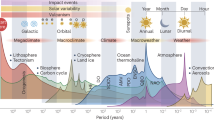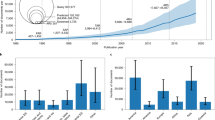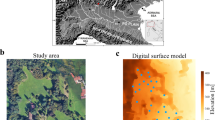Abstract
Climate over land—where humans live and the majority of food is produced—is changing rapidly, driving severe impacts through extreme heat, wildfires, drought and flooding. Our ability to monitor and model this changing climate is being transformed through new observational systems and increasingly complex Earth system models. But fundamental understanding of the processes governing land climate has not kept pace, weakening our ability to interpret and utilize data from these advanced tools. Here we argue that for land-climate science to accelerate forwards, an alternative approach is needed. We advocate a parallel scientific effort, one emphasizing robust theories, that aims to inspire current and future land-climate scientists to better comprehend the processes governing land climate, its variability and extremes and its sensitivity to global warming. Such an effort, we believe, is essential to better understand the risks people face, where they live, in an era of climate change.
This is a preview of subscription content, access via your institution
Access options
Access Nature and 54 other Nature Portfolio journals
Get Nature+, our best-value online-access subscription
27,99 € / 30 days
cancel any time
Subscribe to this journal
Receive 12 print issues and online access
269,00 € per year
only 22,42 € per issue
Buy this article
- Purchase on SpringerLink
- Instant access to full article PDF
Prices may be subject to local taxes which are calculated during checkout




Similar content being viewed by others
Data availability
The model data used to produce Fig. 1 are provided by the World Climate Research Programme’s Working Group on Coupled Modelling and can be accessed at https://esgf-node.llnl.gov/search/cmip6/.
Code availability
The code used to produce Fig. 1 is available from the corresponding author on request.
References
Joshi, M. M., Gregory, J. M., Webb, M. J., Sexton, D. M. H. & Johns, T. C. Mechanisms for the land/sea warming contrast exhibited by simulations of climate change. Clim. Dyn. 30, 455–465 (2008).
Pfahl, S., O’Gorman, P. A. & Fischer, E. M. Understanding the regional pattern of projected future changes in extreme precipitation. Nat. Clim. Change 7, 423–427 (2017).
Milly, P. C. & Dunne, K. A. Colorado river flow dwindles as warming-driven loss of reflective snow energizes evaporation. Science 367, 1252–1255 (2020).
Held, I. M. & Soden, B. J. Robust responses of the hydrological cycle to global warming. J. Clim. 19, 5686–5699 (2006).
Greve, P. et al. Global assessment of trends in wetting and drying over land. Nat. Geosci. 7, 716–721 (2014).
Schmidt, D. F. & Grise, K. M. The response of local precipitation and sea level pressure to Hadley cell expansion. Geophys. Res. Lett. 44, 10573–10582 (2017).
Berg, A. & Sheffield, J. Evapotranspiration partitioning in CMIP5 models: uncertainties and future projections. J. Clim. 32, 2653–2671 (2019).
Cook, B. I. et al. Twenty-first century drought projections in the CMIP6 forcing scenarios. Earths Future 8, E2019EF001461 (2020).
Hohenegger, C. & Stevens, B. Tropical continents rainier than expected from geometrical constraints. AGU Adv. 3, E2021AV000636 (2022).
Simpson, I. R. et al. Observed humidity trends in dry regions contradict climate models. Proc. Natl Acad. Sci. USA 121, e2302480120 (2024).
Lee, Y.-C. & Wang, Y.-C. Evaluating diurnal rainfall signal performance from CMIP5 to CMIP6. J. Clim. 34, 7607–7623 (2021).
Seneviratne, S. I. et al. Impact of soil moisture–climate feedbacks on CMIP5 projections: first results from the GLACE-CMIP5 experiment. Geophys. Res. Lett. 40, 5212–5217 (2013).
Swann, A. L. S. Plants and drought in a changing climate. Curr. Clim. Change Rep. 4, 192–201 (2018).
Lambert, F. H. & Chiang, J. C. H. Control of land–ocean temperature contrast by ocean heat uptake. Geophys. Res. Lett. 34, L13704 (2007).
Teng, H., Leung, R., Branstator, G., Lu, J. & Ding, Q. Warming pattern over the Northern Hemisphere midlatitudes in boreal summer 1979–2020. J. Clim. 35, 3479–3494 (2022).
Best, M. J. et al. The plumbing of land surface models: benchmarking model performance. J. Hydrometeorol. 16, 1425–1442 (2015).
Haughton, N. et al. The plumbing of land surface models: Is poor performance a result of methodology or data quality? J. Hydrometeorol. 17, 1705–1723 (2016).
Haughton, N., Abramowitz, G. & Pitman, A. J. On the predictability of land surface fluxes from meteorological variables. Geosci. Model Dev. 11, 195–212 (2018).
Li, Z.-L. et al. Soil moisture retrieval from remote sensing measurements: current knowledge and directions for the future. Earth Sci. Rev. 218, 103673 (2021).
Willett, K. et al. HadISDH land surface multi-variable humidity and temperature record for climate monitoring. Clim. Past 10, 1983–2006 (2014).
Pongratz, J. et al. Land use effects on climate: current state, recent progress, and emerging topics. Curr. Clim. Change Rep. 7, 99–120 (2021).
Hohenegger, C. et al. ICON-Sapphire: simulating the components of the Earth system and their interactions at kilometer and subkilometer scales. Geosci. Model Dev. 16, 779–811 (2023).
Beven, K. J. & Cloke, H. L. Comment on: ‘Hyperresolution global land surface modeling: Meeting a grand challenge for monitoring Earth’s terrestrial water’ by Eric F. Wood et al. Water Resour. Res. 48, W01801 (2012).
Fan, Y. et al. Hillslope hydrology in global change research and Earth system modeling. Water Resour. Res. 55, 1737–1772 (2019).
Barlage, M., Chen, F., Rasmussen, R., Zhang, Z. & Miguez-Macho, G. The importance of scale-dependent groundwater processes in land–atmosphere interactions over the central United States. Geophys. Res. Lett. 48, E2020GL092171 (2021).
Pongratz, J. et al. Models meet data: challenges and opportunities in implementing land management in Earth system models. Glob. Change Biol. 24, 1470–1487 (2018).
Clark, M. P. et al. The evolution of process-based hydrologic models: historical challenges and the collective quest for physical realism. Hydrol. Earth Syst. Sci. 21, 3427–3440 (2017).
Schneider, T., Lan, S., Stuart, A. & Teixeira, J. Earth system modeling 2.0: a blueprint for models that learn from observations and targeted high-resolution simulations. Geophys. Res. Lett. 44, 12–396 (2017).
Wulfmeyer, V. et al. Estimation of the surface fluxes for heat and momentum in unstable conditions with machine learning and similarity approaches for the LAFE data set. Boundary Layer Meteorol. 186, 337–371 (2023).
Dagon, K., Sanderson, B. M., Fisher, R. A. & Lawrence, D. M. A machine learning approach to emulation and biophysical parameter estimation with the Community Land Model, version 5. Adv. Stat. Climatol. Meteorol. Oceanogr. 6, 223–244 (2020).
Yuval, J. & O'Gorman, P. A. Stable machine-learning parameterization of subgrid processes for climate modeling at a range of resolutions. Nat. Commun. 11, 3295 (2020).
Zanna, L. & Bolton, T. Data-driven equation discovery of ocean mesoscale closures. Geophys. Res. Lett. 47, E2020GL088376 (2020).
Betts, A. K. Idealized model for equilibrium boundary layer over land. J. Hydrometeorol. 1, 507–523 (2000).
Brubaker, K. L. & Entekhabi, D. An analytic approach to modeling land–atmosphere interaction: 1. Construct and equilibrium behavior. Water Resour. Res. 31, 619–632 (1995).
Findell, K. L. & Eltahir, E. A. Atmospheric controls on soil moisture–boundary layer interactions. Part I: framework development. J. Hydrometeorol. 4, 552–569 (2003).
McColl, K. A. & Rigden, A. J. Emergent simplicity of continental evapotranspiration. Geophys. Res. Lett. 47, E2020GL087101 (2020).
Scheff, J., Coats, S. & Laguë, M. M. Why do the global warming responses of land-surface models and climatic dryness metrics disagree? Earths Future 10, E2022EF002814 (2022).
Klein, S. A. & Hall, A. Emergent constraints for cloud feedbacks. Curr. Clim. Change Rep. 1, 276–287 (2015).
Byrne, M. P. & O’Gorman, P. A. Land–ocean warming contrast over a wide range of climates: convective quasi-equilibrium theory and idealized simulations. J. Clim. 26, 4000–4016 (2013).
Sherwood, S. & Fu, Q. A drier future? Science 343, 737–739 (2014).
Manabe, S., Stouffer, R. J., Spelman, M. J. & Bryan, K. Transient responses of a coupled ocean–atmosphere model to gradual changes of atmospheric CO2. Part I. Annual mean response. J. Clim. 4, 785–818 (1991).
Arakawa, A. & Schubert, W. H. Interaction of a cumulus cloud ensemble with the large-scale environment, part I. J. Atmos. Sci. 31, 674–701 (1974).
Sobel, A. H. & Bretherton, C. S. Modeling tropical precipitation in a single column. J. Clim. 13, 4378–4392 (2000).
Byrne, M. P. & O’Gorman, P. A. Link between land–ocean warming contrast and surface relative humidities in simulations with coupled climate models. Geophys. Res. Lett. 40, 5223–5227 (2013).
Berg, A. et al. Land–atmosphere feedbacks amplify aridity increase over land under global warming. Nat. Clim. Change 6, 869–874 (2016).
Zhang, Y., Held, I. & Fueglistaler, S. Projections of tropical heat stress constrained by atmospheric dynamics. Nat. Geosci. 14, 133–137 (2021).
Duan, S. Q., Findell, K. L. & Fueglistaler, S. A. Coherent mechanistic patterns of tropical land hydroclimate changes. Geophys. Res. Lett. 50, e2022GL102285 (2023).
Byrne, M. P. & O’Gorman, P. A. Trends in continental temperature and humidity directly linked to ocean warming. Proc. Natl Acad. Sci. USA 115, 4863–4868 (2018).
Byrne, M. P. & O’Gorman, P. A. Understanding decreases in land relative humidity with global warming: conceptual model and GCM simulations. J. Clim. 29, 9045–9061 (2016).
Buzan, J. R. & Huber, M. Moist heat stress on a hotter Earth. Annu. Rev. Earth Planet. Sci. 48, 623–655 (2020).
Byrne, M. P. Amplified warming of extreme temperatures over tropical land. Nat. Geosci. 14, 837–841 (2021).
Teuling, A. et al. A regional perspective on trends in continental evaporation. Geophys. Res. Lett. 36, L02404 (2009).
Seneviratne, S. I., Lüthi, D., Litschi, M. & Schär, C. Land–atmosphere coupling and climate change in Europe. Nature 443, 205–209 (2006).
Pastorello, G. et al. The FLUXNET2015 dataset and the ONEFlux processing pipeline for eddy covariance data. Sci. Data 7, 225 (2020).
Mueller, B. & Seneviratne, S. I. Systematic land climate and evapotranspiration biases in CMIP5 simulations. Geophys. Res. Lett. 41, 128–134 (2014).
McColl, K. A., Salvucci, G. D. & Gentine, P. Surface flux equilibrium theory explains an empirical estimate of water-limited daily evapotranspiration. J. Adv. Model. Earth Syst. 11, 2036–2049 (2019).
Chen, S., McColl, K. A., Berg, A. & Huang, Y. Surface flux equilibrium estimates of evapotranspiration at large spatial scales. J. Hydrometeorol. 22, 765–779 (2021).
Budyko, M. I.Climate and Life (Academic Press, 1974).
Monteith, J. L. Evaporation and surface temperature. Q. J. R. Meteorol. Soc. 107, 1–27 (1981).
Scheff, J. & Frierson, D. M. W. Scaling potential evapotranspiration with greenhouse warming. J. Clim. 27, 1539–1558 (2014).
Milly, P. C. D. & Dunne, K. A. Potential evapotranspiration and continental drying. Nat. Clim. Change 6, 946–949 (2016).
Dai, A. in Terrestrial Water Cycle and Climate Change: Natural and Human-Induced Impacts (eds Tang, Q. & Oki, T.) 17–37 (John Wiley & Sons, 2016).
Yang, Y., Roderick, M. L., Zhang, S., McVicar, T. R. & Donohue, R. J. Hydrologic implications of vegetation response to elevated CO2 in climate projections. Nat. Clim. Change 9, 44–48 (2019).
Wehrli, K., Guillod, B. P., Hauser, M., Leclair, M. & Seneviratne, S. I. Identifying key driving processes of major recent heat waves. J. Geophys. Res. Atmos. 124, 11746–11765 (2019).
Seager, R. et al. Dynamical and thermodynamical causes of large-scale changes in the hydrological cycle over North America in response to global warming. J. Clim. 27, 7921–7948 (2014).
Kang, S. M., Held, I. M., Frierson, D. M. & Zhao, M. The response of the ITCZ to extratropical thermal forcing: idealized slab–ocean experiments with a GCM. J. Clim. 21, 3521–3532 (2008).
Bordoni, S. & Schneider, T. Monsoons as eddy-mediated regime transitions of the tropical overturning circulation. Nat. Geosci. 1, 515–519 (2008).
Hohenegger, C. & Stevens, B. The role of the permanent wilting point in controlling the spatial distribution of precipitation. Proc. Natl Acad. Sci. USA 115, 5692–5697 (2018).
Zhou, W. & Xie, S.-P. A hierarchy of idealized monsoons in an intermediate GCM. J. Clim. 31, 9021–9036 (2018).
Biasutti, M., Russotto, R. D., Voigt, A. & Blackmon-Luca, C. C. The effect of an equatorial continent on the tropical rain belt. Part I: annual mean changes in the ITCZ. J. Clim. 34, 5813–5828 (2021).
Geen, R., Bordoni, S., Battisti, D. S. & Hui, K. Monsoons, ITCZs, and the concept of the global monsoon. Rev. Geophys. 58, e2020RG000700 (2020).
Woollings, T. et al. Blocking and its response to climate change. Curr. Clim. Change Rep. 4, 287–300 (2018).
Simmons, A. J., Willett, K. M., Jones, P. D., Thorne, P. W. & Dee, D. P. Low-frequency variations in surface atmospheric humidity, temperature, and precipitation: inferences from reanalyses and monthly gridded observational data sets. J. Geophys. Res. Atmos. 115, D01110 (2010).
Vargas Zeppetello, L. R., Trevino, A. M. & Huybers, P. Disentangling contributions to past and future trends in US surface soil moisture. Nat. Water 2, 127–138 (2024).
Berg, A., Sheffield, J. & Milly, P. C. Divergent surface and total soil moisture projections under global warming. Geophys. Res. Lett. 44, 236–244 (2017).
Zhang, Y. & Boos, W. R. An upper bound for extreme temperatures over midlatitude land. Proc. Natl Acad. Sci. USA 120, E2215278120 (2023).
Williams, A. I. & O’Gorman, P. A. Summer–winter contrast in the response of precipitation extremes to climate change over Northern Hemisphere land. Geophys. Res. Lett. 49, E2021GL096531 (2022).
Byrne, M. P. & O’Gorman, P. A. The response of precipitation minus evapotranspiration to climate warming: why the ‘wet-get-wetter, dry-get-drier’ scaling does not hold over land. J. Clim. 28, 8078–8092 (2015).
Dai, A., Zhao, T. & Chen, J. Climate change and drought: a precipitation and evaporation perspective. Curr. Clim. Change Rep. 4, 301–312 (2018).
Mankin, J. S., Seager, R., Smerdon, J. E., Cook, B. I. & Williams, A. P. Mid-latitude freshwater availability reduced by projected vegetation responses to climate change. Nat. Geosci. 12, 983–988 (2019).
Pendergrass, A. G. et al. Flash droughts present a new challenge for subseasonal-to-seasonal prediction. Nat. Clim. Change 10, 191–199 (2020).
Prentice, I. C., Dong, N., Gleason, S. M., Maire, V. & Wright, I. J. Balancing the costs of carbon gain and water transport: testing a new theoretical framework for plant functional ecology. Ecol. Lett. 17, 82–91 (2014).
Anderegg, W. R. et al. Woody plants optimise stomatal behaviour relative to hydraulic risk. Ecol. Lett. 21, 968–977 (2018).
Wenzel, S., Cox, P. M., Eyring, V. & Friedlingstein, P. Emergent constraints on climate–carbon cycle feedbacks in the CMIP5 Earth system models. J. Geophys. Res. Biogeosci. 119, 794–807 (2014).
Gregory, J. M., Jones, C. D., Cadule, P. & Friedlingstein, P. Quantifying carbon cycle feedbacks. J. Clim. 22, 5232–5250 (2009).
Friedlingstein, P. et al. Climate–carbon cycle feedback analysis: Results from the C4MIP model intercomparison. J. Clim. 19, 3337–3353 (2006).
Arora, V. K. et al. Carbon–concentration and carbon–climate feedbacks in CMIP5 Earth system models. J. Clim. 26, 5289–5314 (2013).
Meinshausen, M., Raper, S. C. B. & Wigley, T. M. L. Emulating coupled atmosphere–ocean and carbon cycle models with a simpler model, MAGICC6—part 1: model description and calibration. Atmos. Chem. Phys. 11, 1417–1456 (2011).
Anderegg, W. R. et al. A climate risk analysis of Earth’s forests in the 21st century. Science 377, 1099–1103 (2022).
Lenton, T. M. et al. Climate tipping points—too risky to bet against. Nature 575, 592–595 (2019).
Braghiere, R. K. et al. Tipping point in North American Arctic-boreal carbon sink persists in new generation Earth system models despite reduced uncertainty. Environ. Res. Lett. 18, 025008 (2023).
Malhi, Y. et al. Exploring the likelihood and mechanism of a climate-change-induced dieback of the Amazon rainforest. Proc. Natl Acad. Sci. USA 106, 20610–20615 (2009).
Pisarchik, A. N. & Feudel, U. Control of multistability. Phys. Rep. 540, 167–218 (2014).
van Nes, E. H., Hirota, M., Holmgren, M. & Scheffer, M. Tipping points in tropical tree cover: linking theory to data. Glob. Change Biol. 20, 1016–1021 (2014).
Vallis, G. K. et al. Isca, v1. 0: a framework for the global modelling of the atmospheres of Earth and other planets at varying levels of complexity. Geosci. Model Dev. 11, 843–859 (2018).
Eyring, V. et al. Overview of the Coupled Model Intercomparison Project Phase 6 (CMIP6) experimental design and organization. Geosci. Model Dev. 9, 1937–1958 (2016).
Clark, M. P. et al. A unified approach for process-based hydrologic modeling: 2. Model implementation and case studies. Water Resour. Res. 51, 2515–2542 (2015).
Santanello, J. A. Jr et al. Land–atmosphere interactions: the LoCo perspective. Bull. Am. Meteorol. Soc. 99, 1253–1272 (2018).
Entekhabi, D. et al. The soil moisture active passive (SMAP) mission. Proc. IEEE 98, 704–716 (2010).
Lehner, F. & Deser, C. Origin, importance, and predictive limits of internal climate variability. Environ. Res. Clim. 2, 023001 (2023).
Acknowledgements
We thank the Carnegie Trust for the Universities of Scotland for generously funding a workshop on land-climate science at the University of St Andrews (6–8 June 2022), which inspired this Perspective. We also thank M. Gomis for graphical assistance with Figs. 2–4. M.P.B. was supported by the UKRI Frontier Research Guarantee scheme (grant number EP/Y027868/1), S.A.H. was funded by NSF award no. 2123327 and A.D. was funded by NSF award no. AGS-2015780.
Author information
Authors and Affiliations
Contributions
M.P.B., G.C.H. and J.S. wrote the initial draft. All authors contributed to editing and revising the manuscript.
Corresponding author
Ethics declarations
Competing interests
The authors declare no competing interests.
Peer review
Peer review information
Nature Geoscience thanks Paul Dirmeyer, Kirsten Findell and the other, anonymous, reviewer(s) for their contribution to the peer review of this work. Primary Handling Editor: Tom Richardson, in collaboration with the Nature Geoscience team.
Additional information
Publisher’s note Springer Nature remains neutral with regard to jurisdictional claims in published maps and institutional affiliations.
Rights and permissions
Springer Nature or its licensor (e.g. a society or other partner) holds exclusive rights to this article under a publishing agreement with the author(s) or other rightsholder(s); author self-archiving of the accepted manuscript version of this article is solely governed by the terms of such publishing agreement and applicable law.
About this article
Cite this article
Byrne, M.P., Hegerl, G.C., Scheff, J. et al. Theory and the future of land-climate science. Nat. Geosci. 17, 1079–1086 (2024). https://doi.org/10.1038/s41561-024-01553-8
Received:
Accepted:
Published:
Issue Date:
DOI: https://doi.org/10.1038/s41561-024-01553-8
This article is cited by
-
The other climate crisis
Nature (2025)



